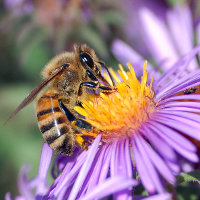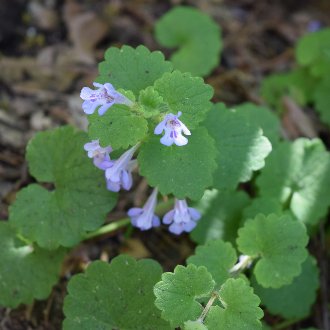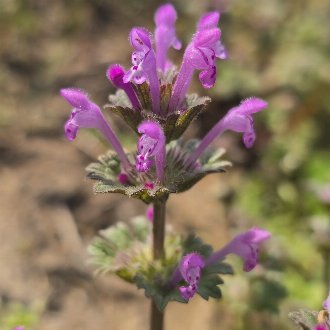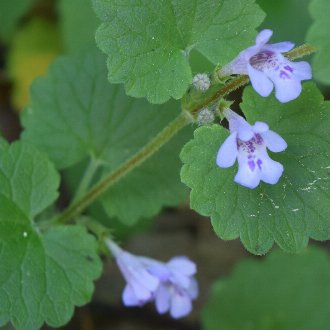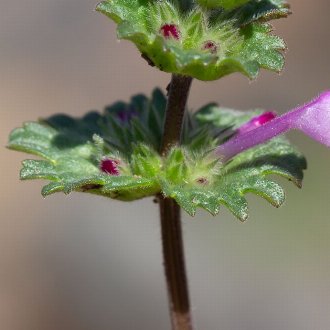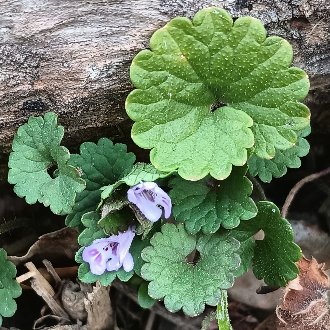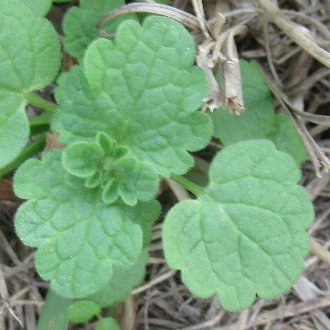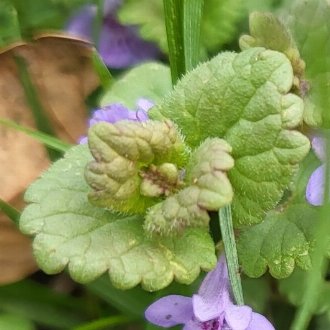Ground Ivy vs Henbit Deadnettle
These two introduced species are often confused; both are common in lawns and gardens, and they are visually similar and can grow together in the same habitat. They can be easily distinguished by upper leaves, flowers, and life cycle. Glechoma hederacea ranges much farther north, can survive in mowed lawns, is present year-round, and is more restricted to part-shade and moist conditions, whereas Lamium purpureum ranges farther south, ranges into full sun and drier conditions, and is absent in summer.
Ground Ivy (Glechoma hederacea) | Henbit Deadnettle (Lamium amplexicaule) |
A perennial native to Europe and widely introduced in North America, where it is common in lawns and gardens. | A low-growing, sprawling annual in the mint family. Native to Europe, Asia, and North Africa, and introduced in North America. |
Flowers average a more bluish hue of purple, and are only rarely a reddish-pink. Flowers are usually more horizontally-oriented, and are distributed a bit more consistently farther down the stem. Photo © , CC BY-SA 4.0. | Flowers average a more reddish hue of pink. Flowers tend to project upwards more, and are heavily clustered at the tips of stems. Photo © Cindy MC wildlydistracted, CC BY 4.0. |
All leaves, even those near the stem tip, under the flower clusters, have a distinct petiole, a stem connecting them to the main stem. Photo © , CC BY-SA 4.0. | Leaves directly under the flower clusters are sessile, attached directly to the main stem without a stem of their own. Pairs of upper leaves often look nearly-fused, like a single leaf wrapping around the stem. Photo © Bill Keim, CC BY 4.0. |
The two sides of the leaf bases reach much farther back than the point of attachment of the petiole, and often overlap each other, or come close to doing so. Photo © Raven Dandridge, CC BY 4.0. | On lower leaves that have a petiole, the two sides of the leaf bases only reach slightly farther back than the point of attachment than the petiole, and do not even come close to overlapping. Photo © Linda Jo Conn, CC BY 4.0. |
All leaves, even upper leaves of mature plants, have consistently-shallow sinuses between lobes or teeth. Sinus depth is consistent over the entire plant. Photo © Isabella O., CC BY 4.0. | Upper leaves of mature plants often have deeper sinuses between lobes or teeth. Sinus depth of leaves tends to be dramatically deeper on these leaves than on the first few leaves of young plants (pictured above.) Photo © cigazze, CC BY 4.0. |
Additional Notes
Both of these plants have distinctive earthy aromas. They can be distinguished by smell, but their fragrances are hard to describe in words. Glechoma hederacea is usually more pungent.Although both these species can survive in lawns, they exhibit different adaptations to doing so. Glechoma hederacea creeps along the ground, retaining leaves along the length of its stem. Mowing removes only upright branches, exposing the lower leaves to more light by removing shading leaves from grass and other plants. Lamium amplexicaule on the other hand can complete its whole lifecycle during the cool season when the lawn is not mowed. It usually produces seed before mowing begins, and then the mowing distributes its seeds, which will germinate in the next fall and reestablish over the winter.
Both of these species can also be confused with purple deadnettle (Lamium purpureum), which is also an annual like Lamium amplexicaule, but that species is usually slightly easier to identify at the time of blooming. All three species can grow together.
References & External Resources
These short lists show only links helpful for ID. For a complete list of references and resources also covering other aspects of ecology, visit the links section of the full article on each plant, which is the first entry here.

